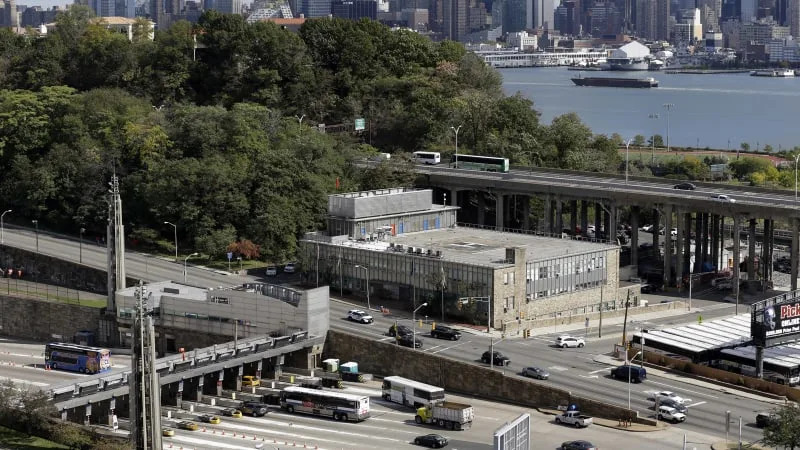Whereas New York Metropolis’s push to cost motorists $15 to enter Manhattan’s congested central enterprise district subsequent yr inched ahead Thursday with the discharge of a beneficial toll construction, a pending lawsuit by New Jersey Gov. Phil Murphy has put that timeline in limbo.
The Metropolitan Transportation Authority, which runs New York Metropolis’s subways, buses and commuter rail traces, desires to start out charging the congestion pricing as quickly as late Spring so it may well use the estimated $1 billion a yr it will generate to modernize a greater than 100-year-old system.
Murphy sued in July, arguing that congestion pricing will power New Jersey commuters who drive into the town to pay for the MTA’s bills. He desires a court docket to require an extended environmental evaluation of the tolling program, which might delay implementation.
That will imply the MTA would wish to attend longer than deliberate for the brand new income. The company has already stated that with out the circulate of cash, it will have to promote bonds which might be repaid from its working funds sooner than anticipated, costing as a lot as $300 million a yr in further debt-service bills. It additionally delayed a $1.3 billion mission to modernize indicators on the A and C subway traces in Brooklyn as a result of its funding depends on congestion pricing receipts.
“We want to see this implemented as quickly as possible,” stated Tom Wright, president and chief govt officer at Regional Plan Affiliation, a nonprofit group that promotes financial well being and environmental resiliency within the New York Metropolis space. “Every day this gets delayed, it really does cost the MTA and it costs people in increased traffic and worsened air quality.”
New York Metropolis’s plan — the primary of its form within the US — would cost motorists coming into south of sixtieth avenue into Manhattan’s central enterprise district. The MTA will then borrow towards that income stream to increase the Second Avenue subway line to a hundred and twenty fifth avenue, add extra elevators and escalators to subway and prepare stations and assist strengthen the transit system towards excessive climate.
About 900,000 automobiles enter the central enterprise district on weekdays, in line with the MTA. It anticipates the proposed toll would cut back that quantity by 17%, or about 150,000 fewer automobiles day by day. Ridership on mass-transit all through the area would improve by 1.5% to 2%, or almost 110,000 further weekday rides.
“Everyone in the region deserves access to more reliable mass transit, but placing an unjustified financial burden on New Jersey commuters is wrong,” Murphy stated in an announcement late Wednesday. “We are left with no choice than to continue addressing our concerns through litigation.”

Tolling proposal
A six-member Site visitors Mobility Assessment Board has been finding out how greatest to implement the brand new price for months and on Thursday launched its suggestions on how one can construction this system.
The TMRB beneficial charging passenger vehicles $15 as soon as a day to enter the district whereas vans pay $24 to $36, in line with the board’s report back to the MTA. There’s a 50% improve for drivers with out an E-ZPass. The price would apply from 5 a.m. to 9 p.m. on weekdays and between 9 a.m. to 9 p.m. on weekends, with tolls 75% decrease through the night time.
The visitors board additionally suggests giving a $5 credit score to passenger automobiles coming into the district by means of 4 tunnels: Queens-Midtown connecting Manhattan to Lengthy Island Metropolis, the Hugh L. Carey — a bypass to downtown Manhattan from Brooklyn, and each the Holland and Lincoln, which hyperlink to New Jersey. Small vans would get a $12 credit score whereas massive vans and tour buses would obtain $20.
New York Metropolis Mayor Eric Adams Thursday described the proposed $15 price as the start of a dialog and raised the necessity to exempt sure drivers going to medical appointments. However he burdened that commuters who selected to drive for ease, should pay the toll.
“We don’t want to overburden working class New Yorkers, but those who are just driving for convenience, whatever the price is, they need to pay that price,” Adams informed reporters Thursday.
John Samuelsen, Transport Employees Union’s worldwide president and a former member of the TMRB, pushed again towards the suggestions. The MTA ought to improve service now with extra specific bus routes in underserved neighborhoods, extra frequent native bus service and expanded hours, Samuelsen wrote in a letter dated Thursday the place he gave his resignation.
“We have a congestion pricing plan that is all stick and no carrot, a half-way scheme that falls well short of the mark,” Samuelsen stated in an announcement. “It will definitely raise revenue. But raising revenue should not have been given priority status over persuading as many New Yorkers as possible to switch from cars to public transit, thus more significantly reducing traffic congestion.”

